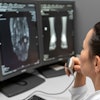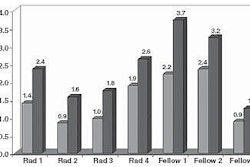The recently published 2007 proposal for the Medicare Physician Fee Schedule (MPFS) doesn't hold much in the way of good news for imaging services. Nuclear medicine and interventional radiology practitioners are looking at a 14% reduction in allowed Medicare charges for the 2007 calendar year, while radiologists are staring at a whopping 16% reimbursement cut for the same time period, according to the U.S. Centers for Medicare and Medicaid Services (CMS).
There may be one ray of light, albeit faint, in an otherwise gloomy reimbursement forecast for next year -- CMS appears as though it may be taking the first steps toward reining in self-referral for diagnostic testing; although in this instance, the self-referral abuse it explicitly seeks to curb has to do with the practice of pathology.
Specifically, the agency expressed concern over the growth of pod or condo laboratories.
"In a typical pod lab arrangement involving pathology services, an entity leases space in a medical building and then subdivides the space into separate areas or cubicles, which are equipped with microscopes and a minimal amount of other laboratory equipment," CMS wrote. "The entity subleases each space to a physician group practice, even though the space may be located many miles away from any medical office of the group practice and is often located in a different state."
"The entity hires a histologist who performs the TC (technical component) of the pathology service, by preparing a microscopic slide of each specimen for review by a pathologist," CMS explained. "The entity also makes arrangements with a pathologist, who performs the PC (professional component) of the pathology service and who also supervises the pod lab."
CMS stated that these sorts of arrangements -- where the TC is performed by one group and the PC by another that reassigns its billing rights to the TC entity, which then bills Medicare globally for the diagnostic test -- are subject to waste, fraud, and abuse. The agency called out the generation of medically unnecessary biopsies, kickbacks, fee-splitting, and referrals that would otherwise be prohibited under the physician self-referral statute as examples of abuse.
In doesn't take a great leap of imagination to swap out "pathology" with "radiology" to envision what subspecialty might be next on the CMS reassignment radar. In fact, CMS acknowledges that in the MPFS document.
"In particular, we are soliciting comments as to whether diagnostic tests in the DHS (designated health services) category of radiology and certain other imaging services should be excepted from any of those provisions; whether the proposal in whole or in part should apply only to pathology services; whether any of these provisions should apply to services performed on the premises of the billing entity and if so, how to define the premises appropriately," CMS wrote. "We are also soliciting suggested regulatory text for the proposal under consideration involving purchased test interpretations, as well as any other comments regarding the appropriate scope of the provisions under consideration."
Teleradiology under fire?
Although CMS is not, at this time, formally proposing an amendment to its regulations, it announced that it is considering significant changes to the reassignment rule. One change could impact those hospital-based radiology groups who contract with independent contractors for teleradiology services to perform official interpretations, according to Thomas Greeson, partner in the Falls Church, VA, office of the law firm Reed Smith.
CMS has asked for comments on the potential of applying the same criteria that exist for purchased interpretations by independent diagnostic testing facilities (IDTFs) to any physician or medical group that bills for the professional component of a diagnostic test for a Medicare patient pursuant to a contractual reassignment.
According to Greeson, in an e-mail to AuntMinnie.com, if CMS were to change the rules in that manner, "hospital-based radiologists could be effectively precluded from billing Medicare for the professional interpretations performed by the teleradiology service for their hospital patients."
This is because the hospital-based radiology group did not also perform and bill for the technical component of the service under its supplier number, according to Greeson. He believes that were CMS to amend the reassignment rule in this manner, many teleradiology arrangements for official interpretation services would need to be reformed.
Greeson also noted that these contemplated changes to the reassignment rule could also affect the ability of nonradiologist, referring physician practices to bill for professional interpretations performed pursuant to a contractual reassignment.
If the reassignment rule were amended to require that the entity that performs the test and bills for the professional component must be independent from the physician/entity that ordered the test, this would effectively preclude a physician practice that performs and bills for imaging services by utilizing the in-office ancillary services exception to the Stark law from billing for the professional component of those services performed by an independent contractor radiologist, because the billing physician practice would be both ordering and performing the technical component of the test.
In effect, Greeson believes that should CMS decide to make such a change, any self-referring physician practice that orders, performs, and bills for the technical component would either need to perform the professional interpretations itself through an employed physician or permit an independent-contractor radiologist to perform the interpretations and bill separately for those services under the radiologist's own supplier number.
Finally, Greeson noted, CMS is considering, but not yet proposing, an additional requirement that in order to qualify as a centralized building under the location requirements of the Stark in-office ancillary services exception, the group practice must staff the space with a nonphysician employee or independent contractor who performs services exclusively for the group practice in that space no less than 35 hours per week.
This latter requirement could have more impact on imaging providers than the various proposed centralized building modifications to the Stark rules that were focused primarily on abuses CMS perceived to certain pathology arrangements. In fact, Greeson pointed out that CMS has indicated that many of the changes to these reassignment rules may exempt radiology services entirely and may be applied to pathology arrangements alone.
Reassignment impacts
Ken Davis, a partner in the Chicago-based law firm Katten Muchin Rosenman, foresees the proposed reassignment rule changes altering the manner in which many radiology practices structure billing arrangements. In an e-mail to AuntMinnie.com, Davis assessed the impact of the proposed rule:
I think the most significant impact would be on the PC of radiology. The contractual arrangement reassignment exception that was created by congressional action in 2003 was intended to make it easier for one Medicare provider to reassign its reimbursement to another Medicare provider. However, the legislation allowed CMS to add 'program integrity safeguards.' CMS apparently perceives that some providers may be abusing the exception and has therefore proposed to impose additional conditions on when a provider can reassign PC.
If ultimately implemented, these new conditions would effectively make it very difficult, if not impossible, for radiologists to reassign the PC to another physician group (e.g., a multispecialty group or an orthopedic group that has an imaging facility) when this other physician group wants to globally bill the PC and TC. Such an approach is pretty common, and would likely have to be restructured so that the radiology group bills the PC separately.
The proposed change would also effectively moot the question many have asked about whether the PC for radiology services provided under the Stark law in-office ancillary services exception, and then billed globally, can be provided offsite. With an eye on the nexus between the reassignment rules and Stark law requirements, providers and their counsel have debated where the PC must be provided for Stark law compliance purposes (if the procedure is billed globally). Under the proposed changes to the reassignment rules, it won't matter anymore: the radiology group would be required to bill the PC separately.
Another impact would be to make it impossible for a radiology group that is reading films for hospital-provided imaging services to use an independently contracted radiologist to provide the 'official' interpretation through teleradiology and then accept reassignment from this contracted provider.
This last point illustrates why it may not make sense to apply the new reassignment conditions to radiology. The sophistication of teleradiology and the extensive ways it can be used (in particular, compared to the use of telemedicine in other specialties) suggests that reassignment of the PC by radiologists should be viewed and treated differently. Indeed, CMS is soliciting comments as to whether diagnostic radiology and certain other imaging services should be excepted from any of the proposed conditions on reassignment.
Davis wrote that CMS is considering imposing the following conditions on a reassignment of the PC of a diagnostic test:
- The test must be ordered by a physician who is financially independent of the person or entity performing the test and also of the physician or medical group performing the interpretation.
- The physician or medical group performing the interpretation does not see the patient.
- The physician or medical group billing for the interpretation must have performed the TC of the test.
Dr. Howard Forman, associate editor of health policy for the American Journal of Roentgenology and professor of diagnostic radiology, public health, and management at Yale University Medical School in New Haven, CT, holds that CMS may finally be looking for ways to control diagnostic imaging self referral.
"My sense was that CMS has created this because of the arrangements that nonradiologists have been making in terms of subleasing facilities for use by their own patients, basically buying time on a piece of equipment, and then billing Medicare for the whole amount (TC and PC portions)," Forman said in an interview with AuntMinnie.com.
"If anything, this is protective of radiologists," he added. "CMS is realizing that the Stark rules don't really work all that well. It may be trying to use the reassignment rules as just another way to kind of enforce Stark even though they're not using Stark as the actual piece of legislation to answer to."
IDTFs on the radar
CMS also set its sights squarely on IDTFs in the 2007 MPFS document, particularly in California.
"Moreover, in recent years, CMS and its contractors have determined that a number of IDTFs in California and other states are perpetrating schemes to defraud the Medicare program," CMS wrote. "The number of IDTFs billing Medicare in California alone increased more than 400% from 2000 to 2005. The increased use of IDTF services has not lowered the use of diagnostic testing within other settings."
According to Davis, the vast majority of radiology IDTFs have little to worry about from enhanced scrutiny of their operations by CMS.
"Most of the 'performance standards' that CMS has proposed should not be a problem for well-run IDTFs," he wrote. "One that could pose a problem, however, would require the IDTF to agree to not directly solicit patients, which includes, but is not limited to, a prohibition on telephone, computer, or in-person contacts. What's unclear from CMS' comments is whether this condition would require IDTFs to cease all public advertisements or marketing (other than to physicians and other Medicare suppliers)."
"Another proposed change that would, at a minimum, cause compliance heartburn for IDTFs, as well as for radiology groups, is a new supervision rule that would limit physicians to providing supervision to no more than three IDTF sites," Davis noted.
"If implemented, IDTFs would need to regularly confirm that their designated supervising physicians are in compliance with the condition," he wrote. "Similarly, it's not uncommon for radiology groups to designate a subset of the group to always be their supervising physicians for IDTFs that they staff. The proposed rule would require these groups to spread the supervision obligations among more radiologists."
If interested in commenting on the CMS proposals, online submissions can be made via the CMS Web site for "CMS-1321-P - Medicare Program; Revisions to Payment Policies Under the Physician Fee Schedule for Calendar Year 2007 and other Changes to Payment Under Part B." The comment period ends October 10.
By Jonathan S. Batchelor
AuntMinnie.com staff writer
August 18, 2006
Related Reading
CMS proposes 54% cut in mammo CAD reimbursement, August 15, 2006
CMS scales back contiguous body part cut, modifies outpatient cap, August 9, 2006
HHS releases final 'safe harbors' rules for health IT, August 2, 2006
DRA cuts affect more than imaging providers, August 2, 2006
House bill seeks to delay DRA imaging cuts, June 29, 2006
Copyright © 2006 AuntMinnie.com



















